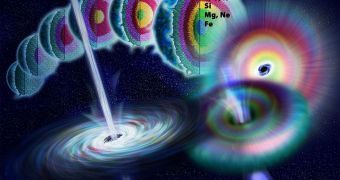Over the past few years, the international scientific community has been fascinated with the possibility that events taking place millions of miles (thousands of light-years) away could influence our planet. While the idea seemed far-fetched at first, numerous studies have in the mean time begun corroborating the hypothesis. And the truth is now showing clearly – gamma-ray bursts (GRB) indeed influence Earth, and may have even caused some of the mass extinctions our planet experienced.
In a recent series of investigations, it was revealed that GRB have the ability to prevent photosynthesis from taking place up to 260 feet (80 meters) below the surface of the world's oceans. This natural process is of extreme importance to life on our planet, given that it allows plants to turn carbon dioxide into oxygen. It is this chemical element that allowed for complex life to develop here, experts argue. With this in mind, it stands to reason that powerful GRB may have caused mass extinctions. By turning off photosynthesis, they starved the Earth of oxygen, killing all complex organisms that depended on the gas.
GRB originate in the massive explosions that accompany the end of a large star's burning cycle. When the celestial object becomes unable of sustaining nuclear fusion, it sheds the outer layers of its atmosphere in a large explosion, and then forms either a neutron star or a black hole. The bursts are widely considered to be among the most energetic phenomena possible in the Universe. But GRB are not only dangerous for processes such as photosynthesis. Experts believe that human observers would be affected by incoming light bursts as well.
“You’d actually see a pretty bright flash. If you’re standing outside looking up at the sky, you might well be blinded by this,” says Washburn University in Kansas astronomer Brian Thomas. He adds that the focused beams of highly-energetic light that make up the GRB can last for more than 10 seconds, and that they carry with them the energy equivalent of billions of nuclear bomb explosions, Wired reports. These elevated energies would not sit well with phytoplankton, the microorganisms that make up the basis of the oceanic food web.
Researchers at the Universidad Central de Las Villas in Cuba, led by biologist Liuba Penate, explain in a paper published in the online journal arXiv that these creatures would be devastated by the intense radiation. One possible effect could be extensive DNA mutations, accompanied by the termination of photosynthesis for at least 10 seconds – the maximum duration of the GRB. But the loss of photosynthesis would be nothing compared to what would happen if phytoplankton's DNA mutated, the team says.

 14 DAY TRIAL //
14 DAY TRIAL //